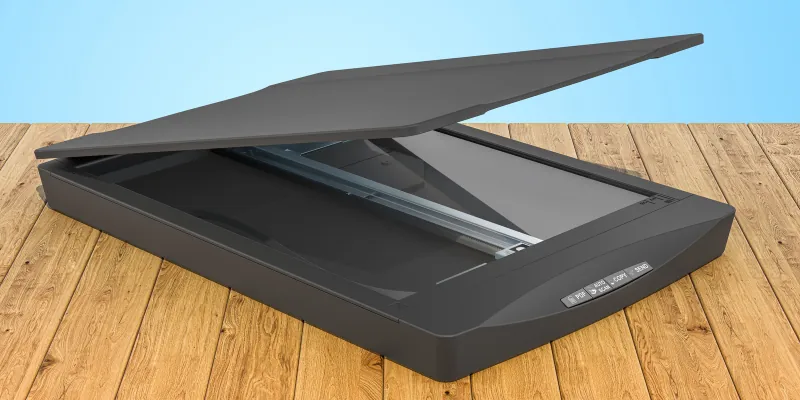Flatbed Scanner Capture Every Detail with Care
Published: 12 May 2025
Did you know that flatbed scanners can capture documents and images at resolutions as high as 1200 DPI or more? Unlike mobile scanning apps, they offer superior clarity and precision, making them perfect for digitizing old photos, important paperwork, and even artwork. Whether you’re a student, a professional, or a hobbyist, a Flatbed Scanner can be an essential tool for preserving and sharing your documents. Let’s get information about Flatbed Scanner.
Introduction
A flatbed scanner is a type of scanner that is used to digitize documents, photos, and images by capturing them in high resolution. It has a glass surface where you place the item to be scanned, and a moving optical sensor beneath the glass reads the image. Flatbed scanners are commonly used in homes and offices for high-quality scanning of papers, books, and pictures.
Importance of Flatbed Scanner?
- High-Quality Scans: Captures clear, sharp images with high resolution.
- Preserves Old Documents: Helps digitize and save fragile photos, books, and papers.
- No Shadows or Distortion: Unlike phone cameras, it ensures even lighting and accuracy.
- Essential for Offices: Used for scanning contracts, IDs, and important paperwork.
- Great for Artists & Photographers: Helps scan artwork and photos without losing detail.

How Does a Flatbed Scanner Work?
- Document Placement: Place the document or photo face-down on the glass scanning bed.
- Lid Closure: Close the lid to block external light for a clearer scan.
- Illumination: The scanner’s light source (LED or fluorescent) lights up the document.
- Optical Sensor Movement: The sensor moves beneath the glass to capture the image line by line.
- Image Processing: The scanner converts the image into a digital format (PDF, JPEG, PNG, etc.).
- File Saving: The scanned file is saved for storage, editing, or sharing.
Types of Flatbed Scanners
- Standard Flatbed Scanner: Used for everyday document and photo scanning.
- Photo Flatbed Scanner: Designed for high-resolution photo and artwork scanning.
- Document Flatbed Scanner: Optimized for text documents, often with OCR support.
- Duplex Flatbed Scanner: Can scan both sides of a page in one pass.
- Large-Format Flatbed Scanner: Used for scanning posters, blueprints, and large artwork.
- Film & Slide Flatbed Scanner: Includes special adapters for scanning film negatives and slides.
Applications of Flatbed Scanner:
- Document Scanning: Digitizes contracts, invoices, and important papers.
- Photo Preservation: Scans old and new photos without damage.
- Book and Magazine Scanning: Helps archive printed content for digital use.
- Artwork Digitization: Captures detailed images of drawings and paintings.
- Legal and ID Scanning: Used for scanning passports, IDs, and official records.
- Education and Research: Assists students and researchers in digitizing study materials.
- Medical and Laboratory Use: Scans X-rays, prescriptions, and medical reports.
- Business and Office Work: Converts paperwork into searchable digital files.
- Film and Slide Scanning: Transfers negatives and slides into digital images.
- Archiving Historical Documents: Preserves rare manuscripts and aged documents.
| Advantages of Flatbed Scanner |
|---|
|
| Disadvantages of Flatbed Scanner |
|---|
|
A flatbed scanner has a glass surface where you place documents or photos, while a sheet-fed scanner pulls in pages automatically. Flatbed scanners are better for delicate items like old photos or books. Sheet-fed scanners are faster for bulk document scanning.
DPI (dots per inch) measures scan resolution, higher DPI means clearer and more detailed scans. For documents, 300 DPI is enough, but for photos, 600 DPI or more is better. Choose higher DPI if you need sharp, high-quality images.
Yes! A flatbed scanner lets you scan books and magazines easily. Just open the book, place it on the glass, and press the lid down gently for a clear scan.
Most modern flatbed scanners are compatible with both Mac and Windows. Some even have Wi-Fi or mobile app support for added convenience. Always check the system requirements before buying.
Only some flatbed scanners support film or negatives. Look for models with a film adapter or transparency scanning feature. Otherwise, you’ll need a dedicated film scanner.
You need OCR (Optical Character Recognition) software to convert scanned documents into editable text. Many scanners come with built-in OCR tools, or you can use free software like Adobe Acrobat or Google Drive. This is useful for digitizing printed documents.
Most scanners let you save scans as PDF, JPEG, PNG, or TIFF. Use PDF for documents, JPEG for photos, and TIFF for high-quality image preservation. Choose based on your needs.
Check if your DPI settings are too low, raise them for better quality. Clean the scanner glass to remove dust or smudges. Also, make sure the document is placed flat and the lid is properly closed.
Yes! Many scanners and scanning software allow multi-page scanning into a single PDF. Just select the “multi-page” or “add another page” option in the software.
Wipe the scanner glass with a soft, lint-free cloth and a little glass cleaner. Avoid using too much liquid. Also, keep the scanner covered when not in use to prevent dust buildup.
Conclusion
So guys, in this article, we’ve covered Flatbed scanners in detail. If you’re looking for high-quality scans without the hassle of blurry images or poor lighting, I highly recommend investing in a good flatbed scanner. It’s perfect for home, office, or creative use. Whether you need to digitize old photos or scan important documents, this device makes it effortless. Now it’s your turn, what will you scan first? Let me know in the comments!

- Be Respectful
- Stay Relevant
- Stay Positive
- True Feedback
- Encourage Discussion
- Avoid Spamming
- No Fake News
- Don't Copy-Paste
- No Personal Attacks

- Be Respectful
- Stay Relevant
- Stay Positive
- True Feedback
- Encourage Discussion
- Avoid Spamming
- No Fake News
- Don't Copy-Paste
- No Personal Attacks
